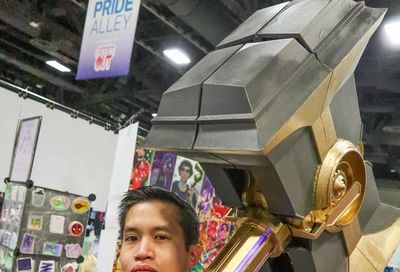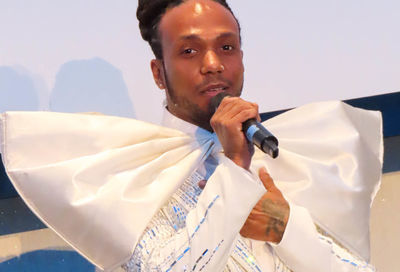Radical Faeries
While the original Don't Be Afraid of the Dark may haunt producer Guillermo del Toro, his remake falls short
A kid’s imagination is terrifying. It puts fang-gnashing meanies in cellars, attributes midnight creaks and moans to wicked poltergeists, and lets God-knows-what hide underneath America’s bed frames. Childhood scares – those awful can’t-sleep, run-to-your-parents kind of frights – are all about what’s not seen, what’s just beyond the veil of observation.
Great horror movies know this; hell, they take advantage of it. That’s why Guillermo del Toro, the Mexican director with a flair for fantastic horror, stepped up to produce and co-write Don’t Be Afraid of the Dark, a remake of a 1973 television movie he was scared stiff by as an impressionable 9-year old. But while plenty of del Toro’s flourishes and themes leak into Dark, it lacks the childish imagination that can turn creeping darkness into nightmarish creations.

Don’t Be Afraid of the Dark
When a sullen, overmedicated girl named Sally Hirst (Bailee Madison) is shipped by her mother across the country “visit” her father, Alex (Guy Pearce), and his girlfriend, Kim (Katie Holmes), she learns that dear old ma doesn’t want to raise her anymore. So, Alex and Kim set the mopey kid up in a gaping, 19th century mansion in Rhode Island, which they’re renovating and hoping to sell. Drawn by mysterious whispers calling her name, Sally finds an abandoned basement, opens a sealed fireplace, and inadvertently unleashes four-inch-tall hell into the shadows of the house.
To be clear: These aren’t the euphemistically wee folk of lore that turn little girls into princesses. These are faeries – borrowers minus the whimsy or good nature, but with added pedophilia, a fetish for deciduous teeth, and a fear of sunlight. Del Toro shoehorns a story about a centuries-old painter who lost his son to the graphemed ones into the plot, but the gist is this: The little bastards want Sally’s pearly whites, but nobody believes her cries for help until it’s too late.
In other words, rookie director Troy Nixey has a lot of nightmare fuel to plumb. And most of the time, his richly detailed visuals are capable enough to do it. When Sally first enters the mansion, we get a terrific sense of how dark and cavernous such a big, ancient house would seem to a kid. (Or, say, a 9-year old del Toro.) Nixey paces his scares at a crawl, letting whispers and shadows build, drip by drip, until the faeries finally show themselves.
Then, everybody laughs. You see, even maniacal faeries are still awful tiny. When the baddies are revealed, Dark loses any claim it had to scare – imagine a tribe of emaciated, hairless guinea pigs and you’ll have a pretty accurate idea of what’s tormenting Sally. While that’s not to say that it was wrong to show the faeries – del Toro has had great success creating frightful monsters in the past – they nonetheless fall flat here. (As does the cast, who snooze through their trope-tastic roles.)


Starring Katie Holmes, Bailee Madison, Guy Pearce
Rated R
99 Minutes
Opens Aug. 26
Area Theaters
What’s ultimately missing from Dark is a reason to believe. Pan’s Labyrinth, another del Toro movie with similar themes of emotional distress and childhood loneliness, made audiences trust by blurring the line between imagination and reality. If Nixie spent more time planting those kinds of questions – Is Sally’s distraught state causing her to hallucinate? Can we trust an unreliable narrator? What’s real and what isn’t? – then perhaps Dark would sit in the mind longer. As is, any fear of teeth-snatching creatures is long gone before the credits roll.
Fear isn’t just universal for people; it’s universal for a person. We remember the frights we had as children and carry them with us as we get older. Although plenty of horror movies must’ve caused a rash of phobias and neuroses, a great one doesn’t necessarily need to scar or damage. All it needs to do is linger. The original Don’t Be Afraid of the Dark has been doing it to del Toro for almost four decades. Just don’t expect this middling remake to do the same.
Support Metro Weekly’s Journalism
These are challenging times for news organizations. And yet it’s crucial we stay active and provide vital resources and information to both our local readers and the world. So won’t you please take a moment and consider supporting Metro Weekly with a membership? For as little as $5 a month, you can help ensure Metro Weekly magazine and MetroWeekly.com remain free, viable resources as we provide the best, most diverse, culturally-resonant LGBTQ coverage in both the D.C. region and around the world. Memberships come with exclusive perks and discounts, your own personal digital delivery of each week’s magazine (and an archive), access to our Member's Lounge when it launches this fall, and exclusive members-only items like Metro Weekly Membership Mugs and Tote Bags! Check out all our membership levels here and please join us today!





















